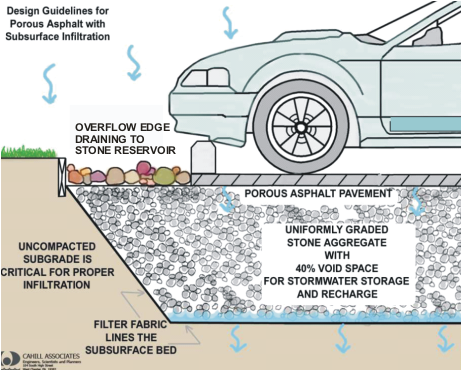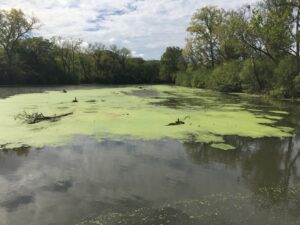Impervious surfaces like concrete and asphalt cover a significant portion of urban and suburban areas, contributing to environmental problems like stormwater runoff. However, a sustainable solution exists—that is, permeable pavement. In this blog post, we will explore permeable pavement, its benefits, various types, and real-life examples.
Permeable pavers are one form of green infrastructure that can help our neighborhoods be more resilient to stormwater issues. If you missed it or need a refresher, read our first blog post in the green infrastructure series to learn what green infrastructure is and how it can help solve stormwater problems in our community.
What is Permeable Pavement?
Permeable pavement, also known as porous or pervious pavement, is designed to allow water to seep through its surface. Below the pavement, there is typically an engineered bed filled with stone that holds stormwater as it slowly soaks into the soil and replenishes groundwater.

Benefits of Permeable Pavement
We’re seeing permeable pavement pop up in more spaces in our community—but why? The benefits of permeable pavement help solve some common problems:
Manage Stormwater
Permeable pavement’s main benefit is as a form of green infrastructure that helps manage stormwater. Since rain can pass through, permeable pavement reduces stormwater runoff—which in turn lessens flooding, erosion, and water pollution. Stormwater is able to soak into the ground and recharge groundwater, which is especially important to communities who source their water from groundwater reserves.
Protect Water Quality
When stormwater can’t soak into the ground, it flows across surfaces, like roads and lawns, and picks up pollutants, such as leaked oil, pet waste, fertilizer, and road salt. The runoff is eventually channeled into storm drains that discharge into rivers and streams—and so, all those pollutants enter our waterways. By reducing stormwater runoff, permeable pavement protects clean water in local streams. Also, if polluted stormwater seeps through permeable pavement, the pollutants are filtered out as stormwater permeates through the pavement, its gravel substrate, and soil.
Relieve Heat Island Effect
While permeable pavement’s main role is to manage stormwater and protect water quality, it can also be used as a tool to cool urban areas. Permeable pavement absorbs and dissipates heat more effectively than conventional surfaces, helping to reduce urban heat island effects and create more comfortable environments.
Types of Permeable Pavement
There are three main types of permeable pavement: permeable pavers, pervious or porous pavement, and plastic grid pavers.
Permeable Pavers
Permeable pavers are pavers with openings or small gaps between pavers that allow water to infiltrate the ground.
Pervious or Porous Pavement
Pervious or porous pavement allows water to drain through the surface itself. Concrete, asphalt, or pavers have pores that stormwater passes through to reach the gravel bed and soil.
Plastic Grid Pavers
This type of permeable pavement is created with a plastic grid that is filled with gravel or soil and grass. The plastic grid provides support for vehicles while allowing water to flow through.


Volunteers, interns, and staff help construct an environmentally friendly parking lot at The Conservation Foundation’s McDonald Farm in Naperville. The completed parking lot consists of an engineered gravel base, plastic grid, topsoil, and grass.
Maintaining Permeable Pavement
Permeable pavers and pervious pavement must be properly installed and maintained to work well. Permeable pavement can clog with debris, sediment, and road salt, which slows stormwater infiltration. Municipalities and businesses can vacuum larger surfaces with a specialized air vacuum sweeper twice per year. Homeowners can prevent clogging by keeping the pavement mostly clear of soil, organic material, and excess winter salt.
Permeable Pavement in Our Community
Permeable pavement is a great option for walkways, driveways, and patios. On a larger scale, permeable pavement can replace impervious concrete and asphalt for sidewalks, driveways, and even roads.
One local example of permeable pavers is the Forest Preserve District of Will County’s Hidden Oaks Nature Center parking lot in Bolingbrook, IL. By opting for a permeable parking lot, the Forest Preserve manages stormwater while preserving the natural environment around it. Additionally, the Nature Center building is certified as LEED Platinum, featuring other sustainable technology and design choices, such as a green roof.
As the need for green infrastructure continues to grow, residents, municipalities, and businesses can choose permeable pavement as an effective tool for reducing flooding and protecting clean water in local rivers and streams.




